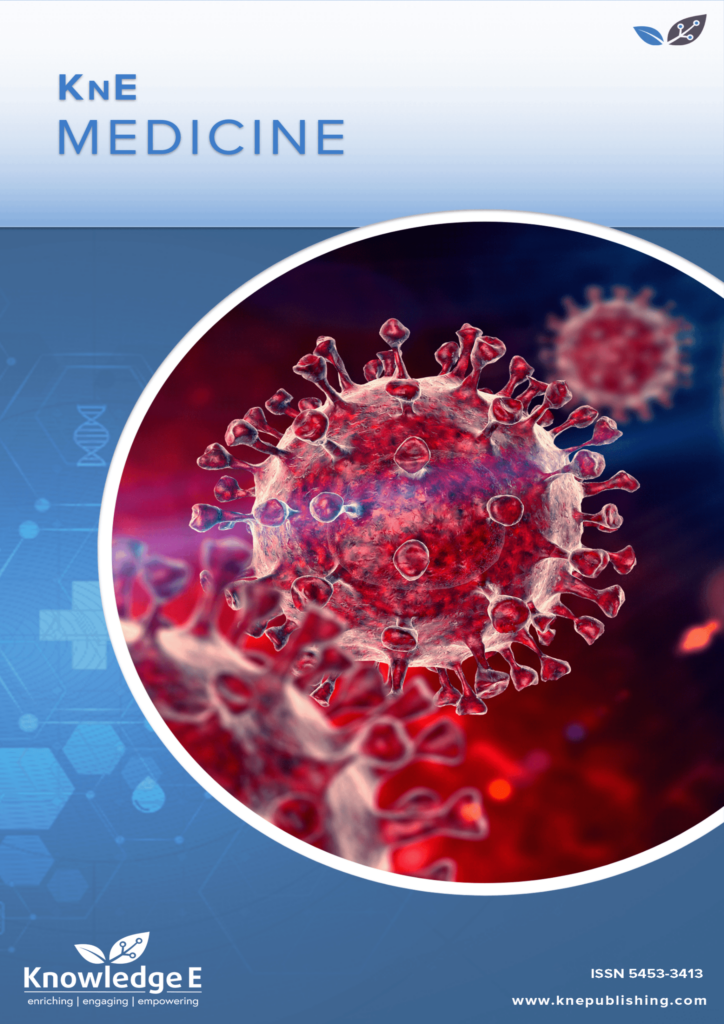
KnE Medicine
ISSN: 2519-125X
The latest conference proceedings on all fields of medicine.
Interaction Between Exercise and Sleep Quality Through Melatonin Synthesis: A Literature Review
Published date: Sep 15 2022
Journal Title: KnE Medicine
Issue title: The International Conference of Medicine and Health (ICMEDH)
Pages: 243–252
Authors:
Abstract:
Irregular exercise or insufficient physical activity may disrupt the biological clock and secretion of the melatonin hormone, which is important in sleep regulation. Regular exercise with a certain intensity and duration can help the body to increase melatonin production which can reduce sleep disorders. A search of full-text articles relevant to exercise and sleep quality was conducted in this literature review. We used four international databases: PubMed, PMC, Wiley Library, and ProQuest. We searched for articles published from 2017 to 2021. After screening the collected articles, only 12 articles were included. The articles were assessed using the JBI appraisal tools and the data were analyzed using descriptive methods. It was found that regular exercise at a certain intensity and duration affects the production of the melatonin hormone in humans. 6 out of the 12 articles revealed that melatonin levels changed in the study participants after doing exercise. Furthermore, 6 other articles mentioned that exercise had an impact on improving sleep quality.
Keywords: physical activity, exercise, sleep quality, melatonin hormone
References:
[1] F. Wang and S. Boros, “Effects of a pedometer-based walking intervention on young adults’ sleep quality, stress and life satisfaction: Randomized controlled trial,.” Journal of Bodywork and Movement Therapies. vol. 24, no. 4, pp. 286–292, 2020.
[2] R. Manggopa and R. Kundre, “Aktivitas Fisik Dengan Kejadian Insomnia Pada Atlit Gym.,” Aktivitas Fisik Dengan Kejadian Insomnia Pada Atlit Gym. vol. 7, no. 2, pp. 1–6, 2019.
[3] F. Marlinda, I. Herawati, and S. Fis, “Hubungan Aktivitas Fisik Dengan Kualitas Tidur Pada Dewasa Awal Di Jakarta Timur.,” p. 2021.
[4] L. Jurado-Fasoli, A. De-la-O, C. Molina-Hidalgo, J.H. Migueles, M.J. Castillo, and F.J. Amaro-Gahete, “Exercise training improves sleep quality: A randomized controlled trial.,” European Journal of Clinical Investigation. vol. 50, no. 3, pp. 1–11, 2020.
[5] A. Al-Sharman, H. Khalil, K. El-Salem, M. Aldughmi, and A. Aburub, “The effects of aerobic exercise on sleep quality measures and sleep-related biomarkers in individuals with Multiple Sclerosis: A pilot randomised controlled trial.,” NeuroRehabilitation. vol. 45, no. 1, pp. 107–115, 2019.
[6] A. Sharma and N. Mehta, “Effectiveness of Exercise Regimen on Sleel Quality in Patients With End Stage Renal Disease on Maintenance Hemodialysis.,” Kidney International Reports. vol. 4, no. 7, pp. S367–S368, 2019.
[7] L.A. Carlson, K.M. Pobocik, M.A. Lawrence, D.A. Brazeau, and A.J. Koch, “Influence of exercise time of day on salivary melatonin responses.,” International Journal of Sports Physiology and Performance. vol. 14, no. 3, pp. 351–353, 2019.
[8] A. Honma, V.L. Revell, P.J. Gunn, et al., “Effect of acute total sleep deprivation on plasma melatonin, cortisol and metabolite rhythms in females.,” European Journal of Neuroscience. vol. 51, no. 1, pp. 366–378, 2020.
[9] X. Li, X. Gao, and J. Liu, “Cross-sectional survey on the relationship between occupational stress, hormone levels, and the sleep quality of oilfieldworkers in Xinjiang, China.,” International Journal of Environmental Research and Public Health. vol. 16, no. 18, p. 2019.
[10] P. Kaylee M, R. Seth A Von, L. Abigail J, D. Amber N, and E. Elizabeth S, “Influence of Aerobic Exercise on Sleep and Salivary Melatonin in Men.,” International Journal of Sports and Exercise Medicine. vol. 6, no. 2, p. 2020.
[11] J.M. Thomas, P.A. Kern, H.M. Bush, et al., “Circadian rhythm phase shifts caused by timed exercise vary with chronotype.,” JCI Insight. vol. 5, no. 3, pp. 12–14, 2020.
[12] S.D. Youngstedt, J.A. Elliott, and D.F. Kripke, “Human circadian phase–response curves for exercise.,” Journal of Physiology. vol. 597, no. 8, pp. 2253–2268, 2019.
[13] S.O. Donnell, C.M. Beaven, G.M. Jacobson, S. Bird, and M.W. Driller, “Melatonin and sleep responses following exercise in elite female athletes.,” The Journal of Sport and Exercise Science. vol. 3, no. 2, pp. 8–13, 2019.
[14] C. Rafie, Y. Ning, A. Wang, X. Gao, and R. Houlihan, “Impact of physical activity and sleep quality on quality of life of rural residents with and without a history of cancer: Findings of the day and night study.,” Cancer Management and Research. vol. 10, pp. 5525–5535, 2018.
[15] A.C.Y. Tse, P.H. Lee, J. Zhang, and E.W.H. Lai, “Study protocol for a randomised controlled trial examining the association between physical activity and sleep quality in children with autism spectrum disorder based on the melatonin-mediated mechanism model.,” BMJ open. vol. 8, no. 4, p. e020944, 2018.
[16] G. Mitrou, C. Giannaki, C. Karatzaferi, et al., “Nocturnal Activity Is Not Affected by a Long-Duration, Low-Intensity Single Exercise Bout.,” Sports. vol. 7, no. 3, p. 56, 2019.
[17] B. Murawski, R.C. Plotnikoff, A.T. Rayward, et al., “Efficacy of an m-Health Physical Activity and Sleep Health Intervention for Adults: A Randomized Waitlist-Controlled Trial.,” American Journal of Preventive Medicine. vol. 57, no. 4, pp. 503–514, 2019.
[18] E.J.L. Widiantini, S. Sugiharto, and O. Andiana, “Pengaruh Olahraga Selama Puasa Terhadap Hormon Melatonin Pada Tikus Putih Jantan Jenis Wistar.,” Jurnal Sport Science. vol. 9, no. 1, p. 84, 2019.
[19] A. Wendt, I.C.M. da Silva, H. Gonçalves, A. Menezes, F. Barros, and F.C. Wehrmeister, “Short-term effect of physical activity on sleep health: A population-based study using accelerometry.,” Journal of Sport and Health Science. vol. 00, pp. 1–9, 2020.
[20] X. Li and X. Gao, “Cross-Sectional Survey on the Relationship Between Occupational Stress , Hormone Levels , and the Sleep Quality of Oilfield Workers in Xinjiang , China.,” p. 2019.
[21] P. Larsen, F. Marino, K. Melehan, K.J. Guelfi, R. Duffield, and M. Skein, “Evening high-intensity interval exercise does not disrupt sleep or alter energy intake despite changes in acylated ghrelin in middle-aged men.,” Experimental physiology. vol. 104, no. 6, pp. 826–836, 2019.